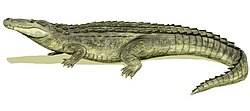| Dzungarisuchus Temporal range: Late Eocene, | |
|---|---|
| Scientific classification | |
| Domain: | Eukaryota |
| Kingdom: | Animalia |
| Phylum: | Chordata |
| Class: | Reptilia |
| Clade: | Archosauromorpha |
| Clade: | Archosauriformes |
| Order: | Crocodilia |
| Family: | Crocodylidae |
| Genus: | † Dzungarisuchus Dong, 1974 |
| Type species | |
| †Dzungarisuchus manacensis Dong, 1974 | |
Dzungarisuchus is an extinct monospecific genus of crocodile. Fossils have been found from Xinjiang, China of late Eocene age. [1] The only remains that have been found have been isolated postcranial and jaw fragments. As a result, the genus is poorly known. All material yet found has been referable to the type species, Dzungarisuchus manacensis.


